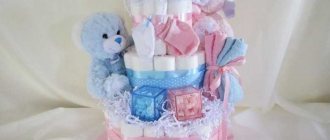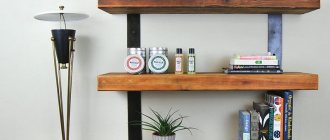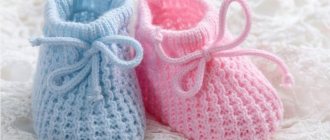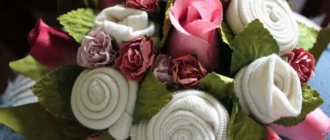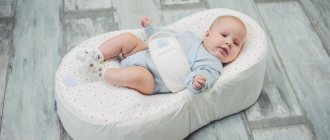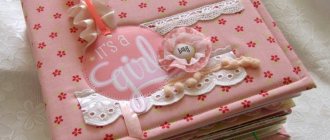A cradle is a small bed for newborns that can be rocked, moved, taken on the road, or placed right next to the parents’ bedside. This product must be durable and strong so that the child does not fall off with a poorly secured lounger during motion sickness.
In this article we will tell you how to make a cradle for newborns with your own hands in different ways. These are products made from waste material and wooden boards, ropes and thick fabric. There are options for weaving from wicker, and there are beautiful cradles made of wool rugs. The main condition for creating a crib is naturalness and environmental friendliness when choosing materials, so that the child does not inhale the “aromas” of synthetics or toxic varnishes and glues.
DIY cradles for newborns are made using natural wood or wool or cotton fabric. To fasten wooden parts, use only PVA glue (D3 or D4), and use only acrylic varnishes or paints for surfaces. They are completely odorless and non-toxic; they are widely used to cover children's toys and furniture.
Low wooden cradle
If the baby's dad has the skills to work with boards, then he can easily make a wooden cradle for a newborn baby with his own hands. Take high-quality boards - dry and clean, without gray spots of mold, so that the baby does not have an allergic reaction. To get wide and tall parts, the boards need to be glued together, making panels of the required size. This will protect them from cracking due to changes in temperature and humidity.
When the boards are ready, cutting is performed. The dimensions of the drawing must correspond to the height of the baby plus 20-30 cm for a pillow and freedom for the legs. The width of the bottom is also determined by placing the baby on a flat surface. It is better if the child can spread his arms to the sides freely.
The sides are cut out in a trapezoidal shape, rounding the parts at the top. The bottom of the bed is rectangular, as are the sides. For beauty, you can make beautiful curves. When the main part of the cradle for newborns is assembled with glue or screws, start working on the rounded legs. They have a flat surface on top, and the bottom part is made semicircular. The legs are made stable using a large radius. The crib should not completely rock, but slightly tilt in one direction and the other so that the baby does not fall out when tilting.
When you have made a cradle for newborns with your own hands, all that remains is to cover it with acrylic varnish. You can line the inside of the crib with fabric so that it stays on top; drill holes in the wooden parts for the laces.
Let's go to the lesson
You can see the process of making a cradle in the example of a master class. We took the diagram from the last drawing and simplified it a little.
We cut out the headboard and legs, then cover them with colorless transparent acrylic varnish.
Next we make the sides.
You can buy these round sticks at the store, then you will need to sand them and glue them to two strips.
Making the bottom of the cradle. As you can see, we make it not from one thick board, but from slats.
We drill holes and begin to assemble the crib.
This is what should happen at this stage.
Cut out the legs in the shape of the letter "L".
Cut out the swing mechanism.
Let's collect it.
At night, you can clamp the discs with clamps so that they stick better.
We present a photo of the cradle that we got, from different angles.
We sew the sides and mattress cover.
Barrel version
A rocking crib for a baby made from a barrel will look very impressive. This DIY cradle for newborns is made up of two main parts. This is the barrel itself, from which a large piece has been cut off, and a wooden stand made of two strong legs and a lintel.
The barrel is attached to the side legs with dowels and mini-fixes made of hard wood. You can screw it on with bolts, securing it with nuts on both sides, adding a lock nut or a lock nut to make the structure reliable.
The remaining parts can be screwed on with screws or, if you have carpentry skills, tied onto tenons. You already understand how to make a cradle for a newborn with your own hands; all that remains is to cover everything with a layer of varnish and line it with fabric from the inside. It is advisable to attach a quilt to prevent the child from hitting the hard walls of the barrel. Don't forget to thoroughly clean the edges of the metal hoops so that they don't tear the fabric and harm your baby.
Criterias of choice
All parents want their child to have a beautiful and comfortable sleeping place. The choice of a cradle is based on several basic criteria that need to be taken into account before purchasing.
Quality of mechanisms
Design safety is one of the most important criteria. Before purchasing, you must make sure that all fasteners and the box itself are secure. To strengthen the mechanism, double fasteners or a crossbar are often used.
A standard single fastening mechanism should consist of:
- hook;
- elastic spring;
- connecting belt (hook with spring);
- carbine;
- rings (for fastening cables).
If all the materials that were used in the production of fasteners are certified and comply with accepted safety standards, then even a classic single fastener will withstand the weight of a child.
Dimensions
Be sure to pay attention to the height of the sides. It should not be less than 30-40 cm. Babies often turn over in their sleep, and if the height is not enough, there is a possibility of falling out of the cradle.
When choosing a cradle, it is necessary to take into account the age and size of the child - some models are intended exclusively for infants, others are recommended for children from six months.
Additional functions
Some types of cradles are equipped with a mechanism for changing the position of the backrest, changing the height of the box above the floor, and seat belts; Some models have removable sides, handles for carrying the basket, and a removable inner fabric cover (for easy washing).
Certain crib designs can be used as a child seat in a car. The main thing is not to forget to securely fasten it.
Material for making the cradle
Material safety is another important criterion. It is better to give preference to natural ones, but if you still purchase a cradle made from an artificial one, you need to find out whether the child will be allergic to it.
The cradle should have a smooth, flat bottom and sides without any protruding parts that could cause injury. The interior upholstery is preferably cotton or linen, preferably soft, with environmentally friendly filling.
Cradle-boat
Another interesting idea for making your own hanging cradle for newborns is a rocking boat. Unfortunately, this is a very difficult job that only an experienced high-level carpenter can do.
Therefore, if you are a carpenter, then you will definitely like the idea of creating such a spectacular cradle boat, as it looks quite original. It is not difficult to make stands for the cradle; these are ordinary legs with a jumper, the upper part of which is slightly raised and rounded. But it’s difficult to make the curved edges of the boat itself. You must have a steam generator and a chamber to steam the board and bend it according to the template of the required size. After cooling, the board remains curved.
Such a cradle is attached to cotton ropes threaded through holes drilled in the boards. To make it more similar to a real boat, small blocks were used, but they serve only a decorative function, since the cradle can neither lower nor rise.
Crocheted newborn hat, detailed with diagrams
Making a crocheted hat is not difficult. Before you begin, you must be able to read diagrams. To do this, you need to know the designations of the columns, which are given below.
But first of all you need to calculate the size. This is easy to do; just divide the volume of your head by 3.14. The resulting number is the size of the product and the diameter of its bottom at the same time. Now choose the yarn and hook. The yarn is marked with the knitting tool and its number. For newborns, it is better to make a simple but very cute hat with ears. They start working from the top. We make a chain of 6 loops and close them into a ring. Air loop (air loop) and knit 12 RLS, in other words, on each RLS in the previous row we knit a pair of RLS. We will have 12 columns. Now we knit 6 more rows with the addition of 6 loops. Respectively 18, 24, 30, 36, 42, 48 loops. We measure the diameter of the bottom, it should be 9 cm. If you have reached the desired number in the next row, we do not make any increases, otherwise we add 6 loops until the desired size is achieved. Row without increments. Subsequently, we add 6 loops and knit again without increments. This will give the cap a slight expansion. Ideally, try the product on a child or on a balloon inflated to 37–38 cm (the volume of a baby’s head). If you need to expand, make increases. If not, then knit further until the depth of the cap is 13 cm. This is exactly what we need. You can decorate it with a bow, lace, or tie on ears.
For summer days, you can knit a balloon cap. Now we will give a detailed description with a diagram. It is designed for infants 3 – 6 months. An openwork headdress is made like this: we make a chain of 5 balloons and close the amigurumi ring. Next are the rows.
- Row 1 – 3 chain stitches, knit 1 dc and a chain loop into the ring, another dc (dc – ch – dc), resulting in 12 stitches.
- 2nd row - we shift the work between the columns, 3 chains on the rise and here we knit a DC, then a fan DC in each gap between the columns of the first row and close the row.
- 3rd row - we move the beginning of the row between the fan columns of the previous row, 3 lifting chains (first column) and 3 more VPs, then in the gaps we knit 1 Dc - 3 VP - 1 Dc, close the end of the row.
- 4th row - we shift the beginning of work to the arch of the previous row, 3 chains on the rise and here we knit 3 dc, after which we pick up the bells and in each arch we knit 4 dc (4 dc - VP - 4 dc), close the row.
- 5th row - move the knitting into the gap between the fan columns of the 4th row and cast on 3 VP for the instep, then 3 VP and knit a DC between 4 DC of the bottom row (DC - 3 VP - DC), close the row.
- Row 6 - we start the row in the first of the received arches and make 3 chain stitches, we knit 2 dc in the same arch, then we make 3 dc in the next arch (3 dc - ch - 3 dc), close the row.
- 7th row - again we move the knitting between the DCs of the previous row and knit 3 VPs for the instep, pick up 2 more air chains and in the next gap we place 2 fan DCs and again 2 VPs and in the gap of 1 DC and repeat (1 DC – 2 air chains – 2 fan DCs – 2 air chains – 1 dc), we close the row. Afterwards you need to try on the bottom for the actual size of the model. It is easy to calculate, head volume / pi (3.14) = bottom diameter. This pattern stretches well, so we subtract 1 – 1.5 cm from the resulting number.
- 8th row - now we make the main pattern, for this we move the beginning of knitting to 2 fan dcs, pick up 3 air stitches and knit 1 dc - ch - 2 dc (4 fan stitches with a middle), a chain of 3 dcs and in the next column we knit 4 fan stitches DC with the middle, and to the end.
- 9th row - we shift the knitting to the middle of 4 fan-shaped Dcs and cast on 3 VPs and knit 1 Dcc - VP - 2 Dcs, after that we cast on a chain of 4 chains and in the middle of the openwork we knit 4 fan-shaped Dcs and knit 4 VPs until the end of the chain.
- Row 10 – cast on 3 chain stitches and knit 1 dc – ch – 2 dc (we have 4 fan stitches with the middle) make 3 ch and tie the chains of the two previous rows making a single crochet (sc) again 3 ch and knit 4 fan dcs, then cast on 3 air stitches and tie two chains of the previous rows in the middle by tying a sc. And to the end of the line (the main drawing of the work).
- Row 11 – 3 chain stitches and knit 1 dc – ch – 2 dc, make a chain of 4 dc and knit 4 fan dc, again 4 ch and 4 fan dc and to the end of the row.
- Row 12 – 3 VP and knit 1 Dc – VP – 2 Dc, assemble a chain of five chain stitches and knit 4 fan Dcs, after which the pattern is repeated.
- Row 13 – 3 chain stitches and knit 1 dc – ch – 2 dc, cast on 3 ch and, clasping two chains of the previous rows in the middle, knit a sc, then knit 4 fan dcs and pick up 3 ch, then twist the chains from the ch of the previous row in the middle and knit RLS. So until the end of the row.
- Row 14 – 3 chain stitches and knit 1 dc – ch – 2 dc, collect a chain of 5 dc and knit 4 fan dc, again 4 ch and 4 fan dc and until the end.
- Row 15 – 3 chain stitches and knit 1 dc – ch – 2 dc, make a chain of 6 chain stitches and knit 4 fan dcs, the pattern is repeated.
- Row 16 – 3 chain stitches and knit 1 DC – VP – 2 DC, 3 chain stitches and clasping a couple of chains of the previous rows in the middle we tie the RLS, then we knit 4 fan DCs and pick up 3 VPs, after which we twist the chains from the VP of the previous row in the middle and knit RLS. Now we knit the hat to a depth of 11 - 13 cm, repeat rows 14, 15 and 16.
Cradle made of slats
For those who like to make wooden structures, there is another option for an original baby crib. It consists of two semicircular planks, for which several boards were first glued together, and then they were cut out from the resulting shields according to a pattern. The next step will be to connect them to each other with a number of identical slats, screwed on with screws on both sides. The bottom of the crib is made flat.
For beauty, stars were cut out on the sides with a jigsaw. All slats must be thoroughly cleaned so that the crib is smooth and safe for the baby.
How to crochet overalls for a newborn, diagram with explanation
For baby and mother, a jumpsuit is a comfortable clothing model. It gives freedom of movement and warms the body. For those who own a crochet hook, it will not be difficult to make it yourself. For this we can propose the following scheme. This item is suitable for both boys and girls. The beginning of knitting comes from the yoke, which we make according to drawing 1 (in the upper right corner of the picture). Using pattern B, we tie the yoke for a more elegant look. The pattern report is knitted according to pattern A. Having knitted a length of 22 cm, you need to divide the knitting and two parts for the legs, and knit another 11 cm. We work the bottom of each of the legs with single crochets. The diagram is detailed and easy to read, so anyone can do it.
Carrycot for newborns
It’s easy to make a crib like the one in the photo below with your own hands. The wooden part of the structure is represented by two identical frames, which are connected at the central side points with bolts. They are held in an upright position by metal folding drawers, screwed to the top of the structure.
If you want to attach a canopy, you will also have to make a corner from slats with a central round stick for putting on the fabric. This design easily folds in half and can be taken with you outdoors or to the country. The cradle itself is made of thick fabric; satin or linen are suitable. A children's mattress is placed on the bottom.
Crochet envelope for a newborn, step by step photo diagram
The envelope is required for the baby's discharge from the maternity hospital. We can bring to your attention a simple model with a hood. We knit a rectangle with a shell ornament, its diagram is attached below.
The length should be 100 - 110 cm, and the width 50 - 60 cm. When the main fabric is knitted, it is necessary to bend the upper two corners and connect them with a cord. This is how we got the hood. Fold the fabric in half and sew 8 buttons on each side on the sides. For spring and autumn, you can insulate the envelope with fleece on the reverse side.
Fabric pendant
You can sew a cradle for newborns with your own hands (photo below) from thick fabric, securing it to a floor beam or ceiling using strong ropes. So that the child can be rocked to sleep, a spring is attached at the junction of all the cords. Be sure to properly strengthen all the knots so that the child is safe and does not fall out of the bed.
The cradle is sewn from rectangular pieces of fabric, and attached to wooden round sticks with sewn wide loops. A mattress is placed at the bottom of the crib. If desired, also sew a canopy, which is simply hung on a spring in the center.
Crocheted costumes for newborns, patterns
There are many styles for babies. For a little girl, a set of an openwork dress, diaper panties and a hat is suitable. The style is simple, the dress is knitted with fan columns, panties and a cap.
Another option suitable for girls is a set of overalls, an openwork blouse, a cap and booties. All items can be worn separately, and thanks to the white color they will go well with any shade.
The boy can be offered a suit of pants with a blouse; they also come with a hat with flaps on the ears. It will be nice to walk in such a suit in spring or autumn.
Another interesting solution is a knitted tracksuit from a famous brand. It looks original, and the baby will be warm and comfortable.
For older fashionistas, you can knit a charming set of an openwork skirt and a jacket decorated with roses. The combination of white, soft pink and green colors is a classic. This suit can be worn when going out.
Macrame cradle
Many women are fond of weaving cords, so it is not surprising that the cradle for a newborn baby was made using the macrame technique. For this work you will need natural, durable cotton rope. The main threads are attached to selected hoops made of wire.
The bottom of the bed is best cut from plywood. Since the child is quite light, you can take the thinnest plywood - 4 mm. First of all, the cords on the upper hoop are fixed with knots. Next, the selected pattern of knots is made around the circumference using a working rope.
When the required height of the crib is reached, attach the lower hoop and weave a tightly mesh for the bottom. When the product is ready, insert the cut piece of plywood. Be sure to clean the edges with sandpaper; it is best to cover it with acrylic paint. Lastly, work on the bottom decorative fringe and make strong ropes to attach the crib to a hook on the ceiling.
Advantages and disadvantages
When making children's furniture, several factors must be taken into account:
- Children will taste the furniture.
The wood itself is soft, and a child’s teething will encourage him to damage the furniture even more often. The crib should be made from environmentally friendly materials. - Until the age of one year, the baby will constantly defecate in bed. And not every diaper or diaper will retain this amount of moisture. There will definitely be leaks. The wood will absorb liquid, which may cause the crib to become deformed. The wood can also rot, which will affect the health of your child.
- Child's age. If the crib is made for a newborn, it is worth considering the possibility of “transforming” it into a cradle.
Based on the above points, we can highlight the advantages of making a crib on your own:
- The bed can be made to individual parameters, with optional functionality.
- Making home furniture will require a much smaller budget.
- All processes are controlled by the parent. The end result will be an environmentally friendly and high-quality product.
Despite the obvious advantages, there are also disadvantages of home production:
- You will need a sufficient amount of free time to search for good material, as well as to progress the work process.
- It is necessary to carefully process each piece of wood so that there are no chips or protruding chips on it.
- To work, you must have minimal metalworking skills in working with wood.
Cocoon cradle for newborns
It’s easy to sew a comfortable portable cradle with your own hands, which is popularly called a cocoon, since it seems to hug the baby from all sides. You can take it with you on the road, on vacation in nature, or put it on the bed next to your mother.
Despite all the apparent complexity, sewing such a cradle is not at all difficult. You will need thick cotton fabric of one or two colors, a zipper, tape for tightening the corners of the cocoon, padding polyester, foam rubber and batting. If you have a sewing machine and very basic sewing skills, then feel free to start sewing such a cocoon, you will definitely succeed.
Crochet items for newborns
The hook gives wide possibilities for use. They knit everything from hats to tops. There are many models for children. You can knit a sleeping bag for toddlers. The model has sleeves, which provides freedom of movement. In such a sleeping bag, the baby will feel calm and confident.
You can knit a set for your baby, consisting of a hat and booties - boots. They will keep your baby warm, and the patterns on the hat will add more charm to the look.
You can knit a dress for your baby. A child will feel comfortable in an openwork outfit made of cotton thread. Natural fiber will not cause allergic reactions.
For your first walks, you can knit a jumpsuit with a hood. It will be cozy, warm and movements will not be constrained.
Also, the child will be comfortable in a jacket. Simple knitting or openwork, it doesn’t matter. Few details are just right for a child. For such a thing it is better to choose natural yarn. This will not be difficult, because... Each manufacturer has a children's range.
Pattern-drawing of a cocoon
The figure below in the article clearly shows all the necessary dimensions for sewing a fabric cocoon for a child. Using this pattern, two identical parts are cut out of fabric. On the wrong side they are sewn along the edges, leaving only the flat lower part unsewn. The soft bottom of the cocoon will subsequently be inserted through this hole. This pocket will be closed with a snake, which needs to be sewn onto its edges.
Next, you need to roll up a “sausage” from padding polyester and insert it along the entire perimeter of the cradle, pressing it tightly against the side seam. Then only on the front side a seam is made along the line marked in blue chalk. All that remains is to cut the foam bottom to the required size, cover it with a layer of thin batting both above and below, and then insert it into the pocket reserved for this purpose in the center of the cocoon and fasten it with a zipper. A wide satin ribbon is sewn onto the edges of the thickened sides to tie a beautiful bow. This closes the cocoon from below.
The article presents several interesting examples of making cradles for newborn babies. Choose the manufacturing method you like and do the work yourself. Good luck!
Main types of baby cradles
A special cradle for the baby is placed in a suspended state so that it can be easily rocked.
Classic woven version made of 100% cotton and wicker twigs
This design can be of several types:
- The classic version of the cradle is usually made of natural wood using weaving techniques. Also, such a cradle can be decorated with forged elements. Two cross arches securely hold the cradle, but at the same time do not interfere with rocking.
- Swing cradle. This product really resembles an ordinary swing, because the sleeping place for the baby is fixed on two supports.
- Automatic cradle. To rock your baby comfortably, you don’t need to make any effort; just press one button. Additionally, such designs can have various accessories - lighting, musical accompaniment, the ability to change the tempo and direction of rocking of the cradle.
- Round crib swing. Mobile and compact. The best assistant for a young mother.
Each mother will be able to find the most suitable option that will match the interior of the room, taste preferences and financial capabilities.
We also recommend that you find out which diapers are best for newborns.
If the area of the children's room is small, it is better to give preference to a hanging cradle-swing. At the end of the support there are special wheels that ensure ease of movement of the structure.
Elegant swing cradle
What to look for when choosing
There are a few important things to consider before purchasing:
- To choose a truly high-quality and safe cradle, you need to carefully study the mechanism of the product. Pay special attention to the reliability and strength of the main fastenings, because the safety of the newborn will depend on them. All fasteners must be made of metal, but in no case plastic or wood.
- The cradle is designed to quickly rock a small child. This product usually has standard sizes. However, if you want your baby to be comfortable while resting, choose a product with the maximum width of the cradle. Then the child will be able to easily roll over during sleep.
- Additional functionality. Some products can be equipped with a basket for small items, a folding changing table and other additions. When buying a cradle, you must take into account one rule - the more additional accessories the product contains, the higher its cost.
- The material from which the cradle is made must be natural and environmentally friendly. This product will retain its attractive appearance for a long time and will not cause allegra in a newborn.
All small removable parts of the hanging cradle must be securely hidden from the baby. It is recommended to choose a product that has not been treated with varnish or paint.
When choosing a wooden suspended structure, ensure the increased reliability of the fastenings
The most useful accessories
Anyone can purchase a ready-made cradle with a full set of all kinds of accessories. However, some young parents want to save money and buy only a cradle, without any additions.
In this case, you will need to purchase the necessary accessories separately:
- A baby's cradle mattress is the most important accessory. The baby's comfortable sleep depends on its quality. Choose a product of the appropriate size; to do this, you need to measure the cradle in advance. Experts recommend giving preference to mattresses made from coconut coir.
- Bed linen made from natural material – cotton is best. It should also be the right size.
- A special cover for the cradle creates a comfortable atmosphere for the newborn and protects from bright light.
- The lock prevents the cradle from swinging too much.
- Rubberized wheels for support are necessary for silent movement of the cradle around the apartment. It is these parts that most often break, so it is recommended to pay special attention to the quality of the material from which they are made.
A felt crib is suitable for winter as it retains heat well
How to choose a high-quality carrying bag in a store, what criteria to consider
The safety and health of the child depends on the quality of the carrying. Experts advise that when choosing such a necessary device for a baby, you should always pay attention to:
- manufacturing material. It must be hypoallergenic and completely safe for the baby. Natural cotton is preferred inside the cradle to minimize the likelihood of irritation and allergic reactions;
- bottom. It should be solid and not bend under the weight of the baby, ideally made of plywood. There are models with a plastic bottom, but experts do not recommend buying them: plastic cannot support the weight of a baby. If you buy a special coconut-based mattress and put it in the cradle, your baby will sleep comfortably;
- pens. They must be comfortable and durable, securely attached to the cradle and be of the required length;
- additional details. A hood, a cradle cover, a rain cover and a mosquito net are very important accessories that protect the baby from wind, bad weather and insects, so their presence in the kit is very desirable.
How to make a cradle from a child's bed for rocking a baby
From the resulting crib you can make a cradle for a newborn . To do this, you will need to modify the legs from the remnants of a chipboard sheet.
What will you need?
A cradle is a small bed for newborns and its exceptional feature is that the cradle is a hanging cradle, a crib that is suspended in the air. In the old days, it was the most common furniture for newborns and, by the way, the most dangerous, both before and now.
All this is due to the fact that if you do not follow the technology or make a mistake in the fastening, or in the material that allows the cradle to hang, then it and the child may simply fall, causing the child to be injured or even break. Before placing your baby in the cradle, check all parts for strength .
To make a cradle, no additional visit to the hardware store is required. All the necessary materials will remain from assembling the crib itself. The cradle will differ only in the runners attached to the legs of the crib.
Tools
To make runners you will need:
- meter and ruler;
- pencil for marking;
- a piece of twine or rope, no more than 2 m;
- large format paper for drawing the runner layout;
- jigsaw;
- screwdriver
Materials
The remains of a chipboard sheet, as well as 4 metal corners 50 by 50 mm and self-tapping screws for fastening, are suitable as a basis for the runners.
As a consumable, you will need a large sheet of paper on which to draw a pattern for the runners.
Step-by-step instructions for designing and installing runners
Before you begin installing the runners, it is worth considering their design . They are made from leftover chipboard. To fasten the runners to the legs of the crib, 4 metal corners are used, as well as self-tapping screws from 2 to 3 cm.
Sizing
One of the most important points is determining the size of the runners. The main thing here is not to make mistakes in sizes and proportions.
Otherwise, the cradle may tip over or not rock at all. To do this, it is important to calculate the radius along which the runners will be cut, as well as their lowest point relative to the legs of the crib. For this project, the lower point of contact of the runners with the floor relative to the beginning of the legs is 5 cm.
Drawing
For convenience, the drawing should be drawn on large format paper . The following parameters must be taken into account:
- The base of the triangle is the distance from the outer edge of one leg to the outer edge of the opposite leg.
- Its top is the lowest point of the runners, located 5 cm below the level of the legs.
After the figure is drawn, you can start drawing the runners:
- To do this, you need to take a pencil and tie a piece of rope to it. It will look like a compass.
- After this, measure out such a radius that the pencil passes through the corner of the base and its top. This will be the required value.
- The length of the rope is fixed and the lower edge of the runners is drawn.
- After this, step back 20 cm and make another top edge.
- Measure the length of the arcs. Usually it is within 25 cm “outside” the legs.
- The paper blank is drawn and cut out again.
An example diagram can be seen below:
Manufacturing of parts
The runners consist of two parts, which are cut out on a paper pattern using a jigsaw.
For beauty, you can make several holes in them using a drill or screwdriver.
Do not drill too many holes , this will affect the overall rigidity of the structure.
Attaching the skids
These elements are installed symmetrically to each other, on opposite sides of the crib. They are attached using metal corners to the legs on the inside of the crib. In this case, the lower arc of the runners should overlap the vertical posts so that the lower corner of each of them is flush with it. Also, for reliability, you can fasten the runners and crib posts from the outside. To do this, you need to carefully drill the runners through the legs and secure them with 72 mm self-tapping screws.
